Abstract
Restaurants across the UK apply different styles of leadership that is dependent on the management strategies. The predominant leadership styles are democratic, autocratic, participatory, and laissez-faire. The research paper reviewed the impacts of these leadership styles on employee motivation within the UK restaurant sector. Through a research survey approach, the study captured leadership styles in six restaurants and their impacts of the motivation of employees. The independent variable was employee motivation while the dependent variables were leadership styles. The correlation analysis indicated that participatory leadership was the most effective in employee motivation followed by democratic, laissez-faire, and autocratic styles. Thus, there is a need to integrate effective leadership with continuous commitment and healthy work environment to complete the motivation matrix.
Introduction
Research Background
In the last two decades, the restaurant sector in the UK has undergone transformation from a linear-based management style to a more proactive, flexible, and dynamic approach (Wilkinson & Redman 2013). Specifically, restaurants within this sector have not been left behind in the quest for optimal service delivery at sustainable organisational management levels. There are several strategies that have been put in place by these restaurants to micro managed labour as a significant factor of production. Moreover, these strategies are designed to ensure optimal output for an even bundle of labour input. It is necessary to review the quantifiable impacts of leadership traits on the level of employee motivation within the complex UK restaurant sector. Thus, this study aims at examining different leadership traits and the magnitude of their impacts on the level of employee motivation. The findings of the study might be applied by restaurants within the UK to effectively manage their employee motivation strategies for optimal performance.
Research Questions and Objectives
Integrating the significance of leadership orientation on the general organizational management, this study focuses on specific traits that impact on the level of employee motivation. Therefore, the researcher generated the following questions and objectives to relate leadership styles to employee motivation at restaurants within the UK.
- How effective are the leadership traits towards a sustainable level of employee motivation within the UK restaurant sector?
- What are the quantifiable consequences of the leadership traits in the management of different employee motivation strategies within the case study restaurants?
Therefore, the research objectives for each question are;
Question 1
- To review the importance of leadership traits in promoting employee motivation within the case study restaurants.
- To ascertain the current leadership management strategies aimed at encouraging employee motivation.
Question 2
- To examine the weight of different leadership traits on different employee motivational strategies within the case study restaurants.
- To establish the quantifiable effects of different motivational strategies as influenced by the predominant leadership style.
Research Significance/Purpose
Since the proposed study will attempt to relate employee motivation to the leadership style in selected restaurants across the UK, the outcomes will form part of a significant strategy for improving standardised employee inspiration through the review of best practices. For instance, restaurants in the UK could use the findings and recommendations to boost employee morale for effective performance of the labour force.
Literature Review
Theoretical Literature Review
Several theoretical frameworks have been put forward to define and relate leadership styles to the level of employee motivation across different sectors. According to Harrison and Wicks (2013), leadership is basically “the intrinsic ability to internalise a setting with the intention of empowering a group or team to proactively and creatively contribute towards problem solving” (p. 103). This means that leadership applications are angled on leadership expectancy, transformation, and Theory X and Theory Y frameworks. For example, the transformational theoretical framework defines the tenets of leadership as creation of a proactive and holistic work environment void of distracters. In application, the transformational leadership framework is associated with “convincing the employees to be flexible to change and perform at their level best” (Dasgupta, Suar & Singh 2013, p. 183). The leadership expectancy framework examines the elements of effectiveness in the entire management process in order to accommodate all the stakeholders (Suma & Lesha 2013). For instance, Obeidat, Masadeh and Abdallah (2014), examined the tenets of expectancy leadership as functional on ethical and practical management of the needs of employees as a motivation for excellence.
The motivational leadership orientation model reviews the significance of different motivation strategies that organizations have put in place to guarantee optimal performance. Specifically, this framework indicates that strategically applied incentives are effective in managing employee expectations while guaranteeing optimal performance, especially in a multifaceted organisation. For instance, the Vroom’s expectancy orientation theory states that leadership motivational direction is efficient towards proactive stimulation of the labour force by encouraging a focus in managing human resource aspects of an organization (Sostrin 2013). This means that the Vroom’s theory provides an explanation on the significance of creating an effective work culture (Arslan & Staub 2013). In addition, the Theory X and Theory Y frameworks are angled on sustainable labour management through the invoking optimal potential of each employee to meet specific expectations (Vanhala & Stavrou 2013)
Empirical Literature Review
Several past research studies on leadership and motivation were reviewed in order to establish the current literature on the impact of leadership traits on employee motivation within the business environment. Among the journal articles examined include Dasgupta, Suar and Singh (2013), Arslan and Staub (2013), Baxter (2015) and Obeidat, Masadeh and Abdallah, (2014). In the research to establish the impact of employee motivation on the general performance of an organisation, Dasgupta, Suar and Singh (2013) observed that leadership strategies have direct and positive impacts on the level of employee motivation and business performance.
The authors concluded organisations with effective managers have a higher probability of employee motivation than businesses with ineffective leaders. Arslan and Staub (2013) carried a research on the impact of Theory X and Theory Y leadership behaviour on organisation performance within the Şishane District in the UK. The findings indicated that organisational management systems and leadership orientation have a direct impact on the level of employee performance since it promotes motivation. The authors concluded that stability in a leadership orientation or behaviour is a prerequisite for creating a holistic and healthy working environment that is motivating to the workforce.
Obeidat, Masadeh and Abdallah, (2014) also researched on the existing relationship in the matrices of organisational commitment, management practices and knowledge processes within the business sector. The findings indicated that selection and application of leadership strategies have different impacts on organisational performance levels, labour management plans and type of organisation. The authors concluded that appropriate selection of leadership behaviour determines the effectiveness of work environment, which is a coefficient of employee motivation. Therefore, there is a need to balance the formal and informal management strategies to guarantee effective employee motivation level.
Lastly, Baxter (2015) studied the process of constructing effective leadership strategies to ensure optimal employee motivation. The findings suggested that properly structured leadership orientation is a significant determinant of a balanced, socially acceptable and holistic work environment in service-based organisations. This means that the creation of healthy communication and work culture is possible through the application of the right leadership behaviour, irrespective of the organisational environment. The authors concluded that balancing time, salience and willingness to integrate employees into the decision making environment guarantee stability in organisational performance with negligible conflict levels. The findings of the empirical literature review indicate that these studies confirm that there is a positive correlation between leadership styles and level of employee motivation in a workplace.
Application of Leadership Traits within the UK Restaurant Sector
The past literature indicates that the UK restaurant sector has experienced a paradigm shift in the quality of service charter as influenced by improved management strategies. As a result, the sector has expanded rapidly over the years, thus, a rise in the number of employees within this business environment (Hospitality &Catering News 2018). The expansion of the restaurant sector has motivated the application of different leadership traits with the aim of improving and sustaining effective performance levels. For instance, most restaurants within the UK have internalised and institutionalised effective performance systems, labour management and communication channels to promote healthy and sustainable relationship between the business and their employees (Hospitality &Catering News 2018). The primary players within the UK restaurant sector are divided into three stars, four stars and five stars restaurants. This study will concentrate on North Port and The Roost (five stars), Everest Inn and Tabla Authentic Indian (four stars) and The Mexican and Odesi (two stars) restaurants. Since the past literature has suggested that different leadership orientations have a direct impact on employee motivation, this research will concentrate on reviewing the choice of leadership styles applied in each restaurant and how they influence the perception of employee on inspiration towards optimal performance.
Relevance of the Literature Review and Research Gap
The leadership theories and empirical review in the literature review suggest that there is a positive relationship between leadership styles and level of employee motivation. In line with the research topic, the literature review confirms that a restaurant practicing an effective leadership management style is likely to have well motivated employees. However, there was little research on the impact of different leadership traits on employee motivation within the UK restaurant sector. Therefore, this research will fill this gap by establishing the link between employee motivation and leadership style in UK restaurants.
Methodology
Research Design
Since the research is focused, subjective and dynamic, the researcher opted for a qualitative survey approach (Saunders, Lewis & Thornhill 2016). Through direct interview and filling questionnaires, the researcher conducted a survey targeting 30 employees in six restaurants (see appendix 1). The researcher ensured that there was a balance the aspects of gender, age and work experience among the targeted respondents (Antonius 2003). The dispatched questionnaires were accompanied by a consent letter (see Appendix 2) to assure the respondents of confidentiality as an ethical concern (Mason 2017). As a remedy for effective data collection, the researcher pre-tested the questionnaire to protect the validity and reliability of the research.
Data Analysis
The collected data were subjected to transcription via the SPSS package to generate cross tabulation to aid in comparative analysis of the findings (Bryman 2008). The researcher then endeavoured to interpret the coded data via the analysis of variance (ANOVA) (Mason 2017). In relation to this study, the ANOVA analysis aimed at establishing the statistical variation in the data collected from the six restaurants (Field 2005). The calculations captured the variance in means of the respondents:
and restaurants:
(Altinay & Paraskevas 2008). In order to carry out the ANOVA analysis, the following hypotheses were created.
Null hypothesis
Ho: µ1 = µ2
The null hypothesis suggests that the mean of sampled restaurants is equivalent to the means of all other restaurants within the UK sector.
Alternative hypothesis
H1: µ1 ≠ µ2
The null hypothesis suggests that the mean of sampled restaurants is not equivalent to the means of all other restaurants within the UK sector.
The null hypothesis will be rejected when the F-critical is smaller than the F-calculated (Robson 2011).
Ethical Considerations
The researcher integrated a consent letter besides seeking permission from the relevant authority to ensure that the study is authenticated (Clough & Nutbrown 2002). The entire research was based on a scientific research approach to address any ethical concerns that might be encountered (Mason 2017).
Limitation and Delimitation of the Methodology
Since the researcher opted for the questionnaire method, the findings may not be adequate to provide a comprehensive inference since the sample space is vulnerable to biases in balancing the demographic characteristics of the respondents (Kristi & Bazeley 2013). However, the questions pre-tested in addition to balancing the demographics to minimise this bias (Smith 2017).
Research Findings and Discussion
Demographic Characteristics of the Respondents
The response rate was 100%, which means that all the targeted respondents dully filled their questionnaires or showed up for the interviews on time (see table 1 and 2).
Table 1. Demographic distribution of the respondents.
Table 2. Summary of number of respondents per restaurant.
For the 30 respondents, coding was done on different leadership traits for mean, rank and standard deviation for the four primary leadership styles (see table 3).
Table 3. Summary of the mean, rank and standard deviation of responses for each leadership style.
The results in table 3 suggest that participatory leadership style has the highest mean (5.2939) seconded by democratic style (4.8559). Autocratic and laissez-faire occupied the third and fourth positions at means of 4.4896 and 4.1757, respectively. Since all the means fall within a single digit, the findings indicate that there was consistency in the responses.
Correlation Analysis
Correlation analysis provides an insight into the degree of existing relationship between the dependent and independent variables, that is, employee motivation and leadership styles. The correlation analysis was carried out to test the following null and alternative hypotheses (see table 4).
- Null hypothesis, Ho: There is no considerable relationship between leadership styles and employee motivation level.
- Alternative hypothesis, H1: There is a considerable relationship between leadership styles and employee motivation level.
The findings of the correlation analysis were tabulated to establish the possible relationship between the variables.
Table 4. Results of the correlation analysis.
As captured in table 4, there is a correlation between employee motivation and each leadership style applied within the UK restaurant sector. The correlation coefficient between participatory leadership style and employee motivation was 0.678, which is the highest. The democratic leadership style followed at 0.652. However, the coefficient for autocratic leadership style was the least at 0.439. Generally, the positive correlation between employee motivation and all the four leadership styles are an indication the independent variable had an impact on the dependent variable.
In establishing the correlation between leadership styles in different types of restaurants, ANOVA analysis was applied for multivariate tests within the UK restaurant sector and the results tabulated (see table 5).
Table 5.Summary of the correlation in application of different leadership styles.
On the basis of the value of mean and standard deviation, participatory leadership style is predominant in all categories of restaurants followed by democratic orientation. However, laissez-faire style is the least practiced among the three categories of restaurants. The researcher further used the ANOVA analysis to quantify the degree of freedom for study indicators using the following null and alternative hypotheses.
Null hypothesis
Ho: µ1 = µ2 = µ3: The null hypothesis means that there are no dissimilarities in application of leadership traits in all categories of restaurants within the UK.
Alternative hypothesis
Ho: µ1 ≠ µ2 ≠ µ3: The alternative hypothesis means that there are dissimilarities in application of leadership traits in all categories of restaurants within the UK.
The results of the ANOVA analysis were summarised and tabulated to establish an existing trend for the categories of restaurants within the UK restaurant sector (see table 6).
Table 6. Degree of freedom in research indicators.
As captured in table 6, the P-value is 0.001 while the F-value is 4.21. This means that the null hypothesis should be rejected at the 99% degree of confidence. This is a confirmation that indicators for employee motivation vary from one restaurant to another within the UK restaurant sector. Therefore, it is in order to conclude that the predominant leadership trait in a restaurant has an impact on the level of employee motivation. This finding confirms the research question that leadership styles have an impact on employee motivation. Specifically, the participatory leadership orientation has the highest positive impact on employee motivation within the UK restaurant sector.
Answers to the close-ended questions
The summary of responses to the twelve questions in part two of the questionnaire (see Appendix 1) was tabulated (see table 7, figure 1 and pie-charts 1 to 12).
Table 7. Summary of responses to the closed-ended questions.
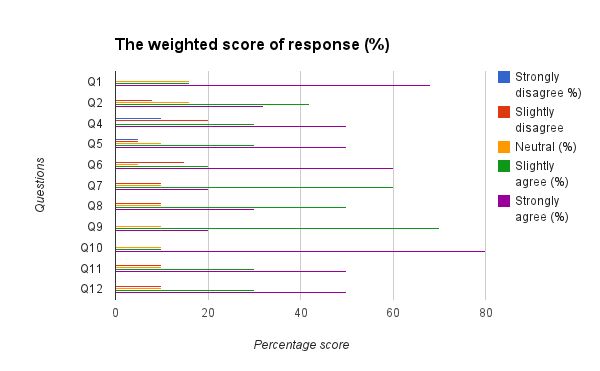
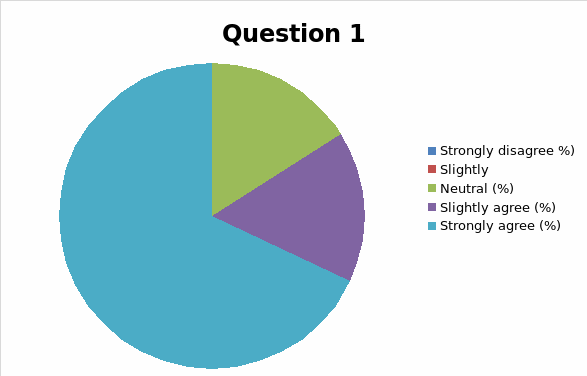

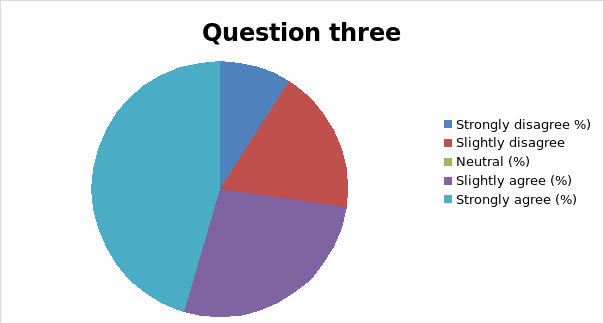
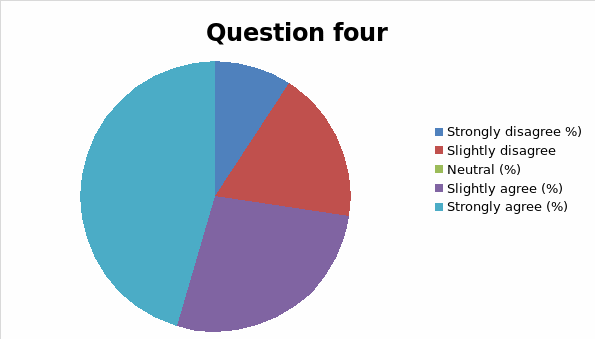
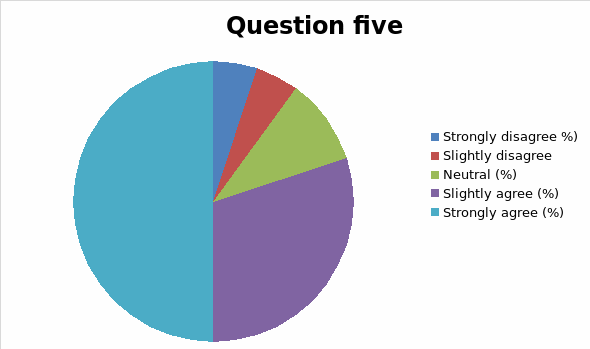

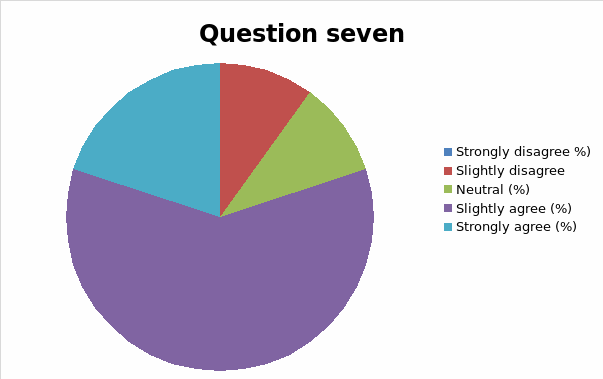
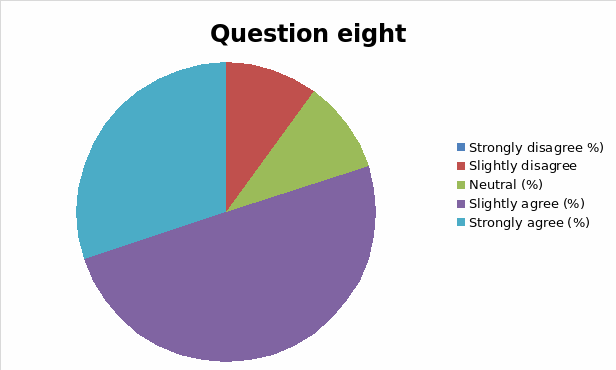
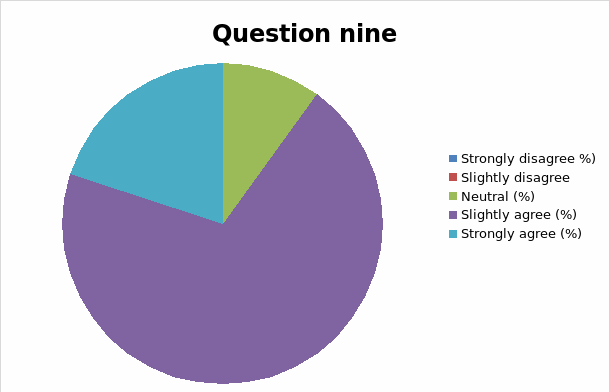
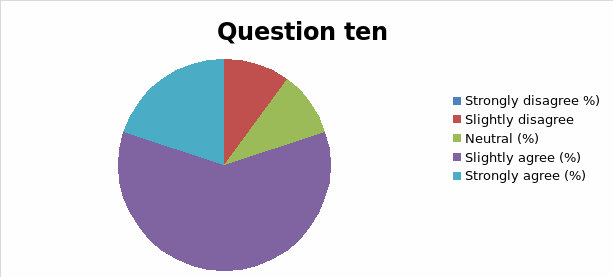
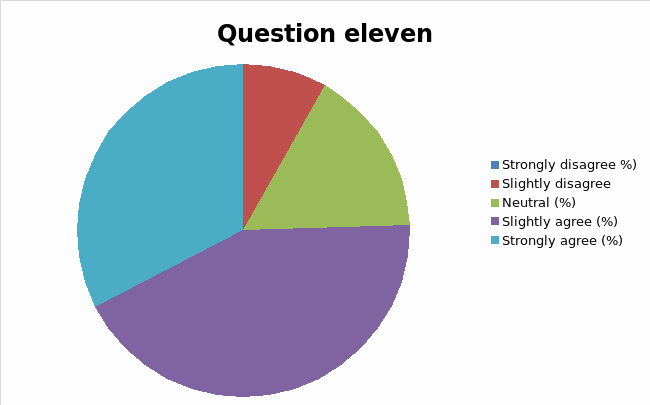
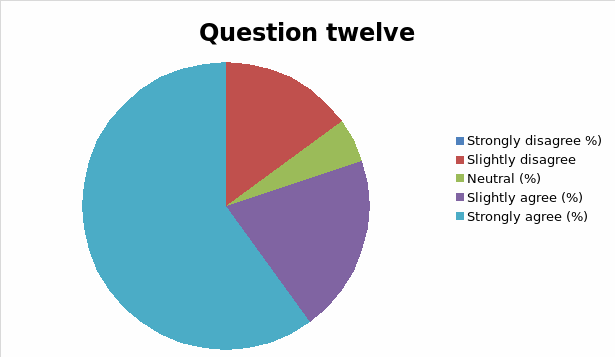
From the pie charts, the respondents clearly associated employee motivation to leadership style in place in the case study restaurants. Specifically, an average score of 87% was obtained in all the questions aimed at establishing the existing link between organisational motivation levels and leadership application.
Conclusion and Recommendations
The findings of the piloted study have answered the two research questions by confirming that different leadership styles have impacts on the level of employee motivation. Apparently, the participatory leadership style is the most predominant and effective in motivating employees within the UK restaurant sector. This was followed by democratic leadership style. However, the least common leadership style in the sector is the laissez-faire orientation. The positive correlation between the dependent and independent variables is an indication that employee motivation is highly influenced by the leadership style or strategies in the UK restaurant sector. Therefore, there is a need for the sector’s management systems to integrate the aspects of employee involvement, commitment, proactive workplace analysis and holistic employee training to guarantee sustainable organisational performance. Moreover, the leadership strategies in the UK restaurant sector should be streamlined and aligned to social responsiveness, planning and management control to boost the aspect of self initiative in leadership application. This will sustain the current positive correlation between specific leadership practices and motivation within the labour force.
Research Timeline and Budget
Research Timeline
The research timeline was generated on the basis of time allocation for each activity (see figure 2).
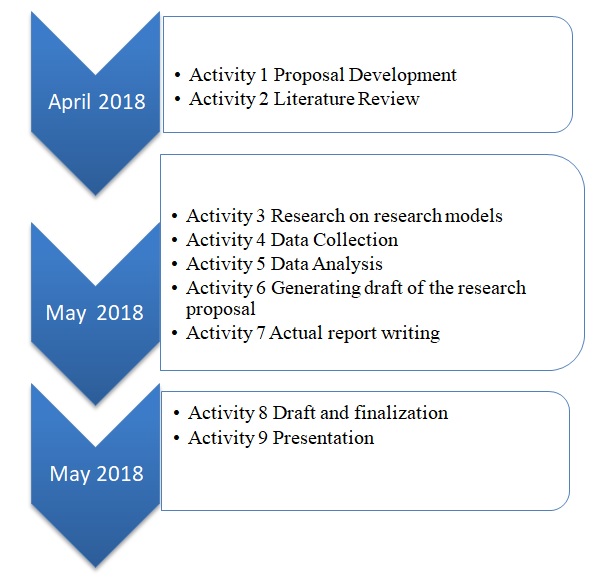
Research Budget
Appendices
Appendix 1: Questionnaire
Part 1: Categorising leadership styles
- I am aware of the following leadership styles.
- Participatory
- Autocratic
- Democratic
- Laissez-faire
- The restaurant I work in practice the following leadership style.
- Participatory
- Autocratic
- Democratic
- Laissez-faire
- I think the most effective leadership style is.
- Participatory
- Autocratic
- Democratic
- Laissez-faire
- I can rate the level of employee motivation in the restaurant I work in as;
- Above average
- Average
- Below average
- Very poor
Part 2: Leadership style and employee motivation
Likert Scale Direction: 1 – Strongly Disagree, 2 – Disagree, 3 – Slightly Disagree, 4 – Neither Disagree nor Agree, 5 – Slightly Agree, 6 – Agree, 7 – Strongly Agree.
- To what extent are you aware of the leadership style(s) practiced in the restaurant you work in?
- Does your restaurant have a predominant leadership style?
- The primary focus of this predominant leadership style is to promote efficiency?
- The leadership style(s) in good and effective to all stakeholders?
- The success of the leadership style is attributed to effective implementation?
- The leadership styles have been effective in motivating employees.
- The content of the leadership style(s) is effective in promoting a healthy work environment?
- Generally, the leadership style in the restaurant has strategies for encouraging stakeholder participation without discrimination.
- I am aware of other restaurants practicing different leadership styles in managing employee.
- I am convinced that the leadership styles in other restaurants are representative of their corporate balance.
- The leadership styles in other restaurants are also effective in motivating employees.
- I am convinced that the leadership styles in the UK restaurant sector are designed to encourage optimal performance?
Appendix 2: Cover Letter/Informed Consent
Dear Correspondent,
This is a special invitation to take part is the proposed research carried out by (insert your name) from the (insert name of your university) under the supervision of (insert the name of your instructor). The research aims at establishing the impression of the impact of leadership application on employee motivation. The proposal is also aimed at substantiating the relationship between different leadership styles and level of employee motivation as perceived by the employees. The study will involve responding to the questions within the questionnaire and provision of demographic information where necessary. The questions revolve around the relationship between management style and how employees perform under each approach. Completing the questionnaire will not take more than ten minutes since the questions are closed-ended. Participating in this research is optimal, that is, you can choose to answer or not respond to the questions in the questionnaire. You should not provide your name or private information that might reveal your identity. After filling the questionnaire, your participation will form part of a huge database in the form of a group data. Only the researcher and the supervisor will have exclusive access to this data.
Completing the questionnaire and returning the same is a manifestation of your confidence and endorsement of this voluntary agreement. There are no direct benefits you may get from participating in the study. You have the alternative of one-on-one interview, phone interview, or filling the questionnaire, especially when your schedule cannot accommodate the first two options. The researcher assures you that the information given will be kept private and will only be used for the intended purpose. You will also not bear in direct or indirect cost for participating in the study as a respondent. Whenever you have a concern or a question, the researcher will be available to make clarification. We encourage you to contact (insert phone number, email, postal address or any other relevant means of reaching you). Kindly be informed that signing this document means that you have relinquished your legal rights to the third party.
Appendix 3: Individual Review Form
Reference List
Altinay, L & Paraskevas, A 2008, Planning research in hospitality and tourism, Butterworth-Heinemann, London.
Antonius, R 2003, Interpreting quantitative data with SPSS, Sage, London.
Arslan, A & Staub, S 2013, ‘Theory X and theory Y type leadership behaviour and its impact on organisational performance: small business owners in the Şishane Lighting and Chandelier District’, Procedia-Social and Behavioural Sciences, vol. 75, no. 1, pp. 102-111.
Baxter, J 2015, ‘Who wants to be the leader? The linguistic construction of emerging leadership in differently gendered teams’, International Journal of Business Communication, vol. 52, no. 4, pp. 427-451.
Bryman, A 2008, Social research methods, 3rd edn, Oxford University Press, Oxford.
Clough, P & Nutbrown, C 2002, A student’s guide to methodology, Sage, London.
Dasgupta, A, Suar, D & Singh, S 2013, ‘Impact of managerial communication styles on employees’ attitudes and behaviours’, Employee Relations, vol. 35, no. 2, pp. 173-199.
Field, A 2005, Discovering statistics using SPSS, 2nd edn, Sage, London.
Harrison, J & Wicks, A 2013, ‘Stakeholder theory, value, and firm performance’, Business Ethics Quarterly, vol. 23, no. 1, pp. 97-124.
Hospitality & Catering News 2018, Industry predictions: what will happen in hospitality in 2018, Web.
Kristi, J & Bazeley, P 2013, Qualitative data analysis with NVivo, SAGE Publications, London.
Mason, J 2017, Qualitative researching, SAGE, London.
Obeidat, Y, Masadeh, R & Abdallah, B 2014, ‘The relationships among human resource management practices, organisational commitment, and knowledge management processes: a structural equation modelling approach’, International Journal of Business and Management, vol. 9, no. 3, pp. 9-26.
Robson, C 2011, Real world research, 3rd edn, John Wiley & Sons Ltd, New York, NY.
Saunders, M, Lewis, P & Thornhill A 2016, Research methods for business students, 7th edn, Pearson Education, Harlow.
Smith, S 2017, Practical tourism research, 2nd edn, CABI, New York, NY.
Sostrin, J 2013, Beyond the job description: how managers and employees can navigate the true demands of the job, Palgrave Macmillan, New York, NY.
Suma, S & Lesha, J 2013, ‘Job satisfaction and organisational commitment: the case of Shkodra municipality’, European Scientific Journal, vol. 9, no. 17, pp. 41–52.
Vanhala, S & Stavrou, E 2013, ‘Human resource management practices and the HRM-performance link in public and private sector organisations in three Western societal clusters’, Baltic Journal of Management, vol. 8, no. 4, pp. 416–437.
Wilkinson, A & Redman, T 2013, Contemporary human resource management: text and cases, 4th edn, Pearson Education, London.